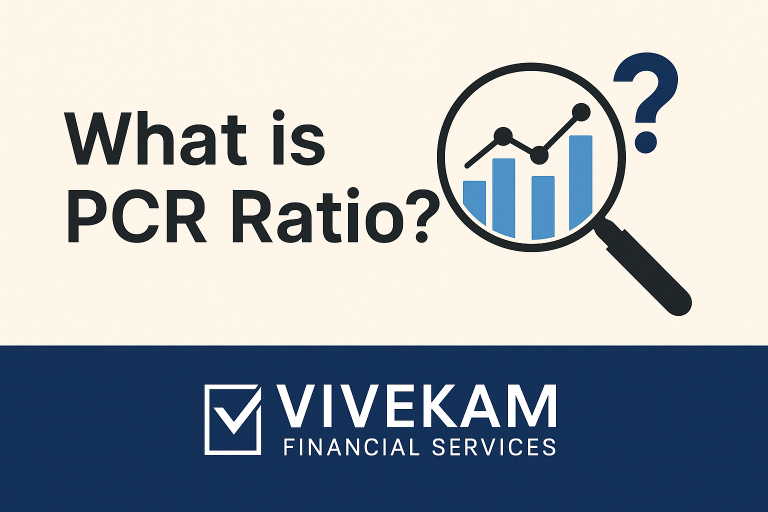What is PCR Ratio? Meaning, Formula & Example

Understanding the market’s mood isn’t guesswork — it’s analysis. And one of the simplest yet most impactful sentiment indicators is the Put Call Ratio (PCR). If you’ve ever wondered What is PCR Ratio? Meaning, Formula & Example, you’re in the right place. By the end of this guide, you’ll know how traders actually use PCR to decode crowd psychology, spot reversals, and avoid walking into traps.
Introduction to Options Trading & PCR
Options trading moves fast, and sentiment swings even faster. That’s why traders depend on indicators that translate market emotions into numbers. PCR is one of those underrated tools that do exactly that: it turns fear and greed into measurable data.
Before diving deep, remember this — PCR doesn’t predict the future. It reveals what traders believe will happen. In the stock market, belief alone can move prices.
Understanding What is PCR Ratio? Meaning, Formula & Example
PCR Full Form Explained
PCR full form is Put Call Ratio, and it does exactly what the name says: compares put option activity to call option activity. Think of it as a mood meter:
- More puts → fear
- More calls → confidence
Simple, yet incredibly telling.
Why PCR value matters in stock market trading
PCR meaning extends beyond definitions — it influences decisions. A rising PCR typically reflects increased hedging, panic, or expectation of a fall. A falling PCR reflects optimism and bullish expectations.
Traders track PCR value because it exposes crowd behavior. When emotions run too high or too low, the market often snaps back the other way — and PCR helps identify those moments.
PCR Ratio Formula: How It Works
The math is as basic as it gets:
PCR Ratio = Total Put Volume / Total Call Volume
But don’t be fooled — simple formulas often have the strongest impact in trading.
Step-by-Step Put Call Ratio Calculation
- Gather total put volume
- Gather total call volume
- Apply the pcr ratio formula
- Assess the sentiment based on the PCR value
Interpreting PCR values (High vs Low PCR)
|
PCR Value |
What it Means |
Sentiment |
|
> 1.0 |
More puts |
Bearish |
|
= 1.0 |
Balanced activity |
Neutral |
|
< 1.0 |
More calls |
Bullish |
Extreme PCR readings often reflect exhaustion — not continuation.
Types of PCR Analysis in Trading
Volume-Based PCR
Volume PCR is the quick-glance snapshot of trader emotions. Since it reacts to intraday spikes, it’s perfect for fast movers and volatility traders.
Open Interest (OI) PCR
OI PCR moves slowly and helps in positional trading. Because open interest reflects commitments — not just momentary trades — this version is more reliable for medium- to long-term sentiment.
PCR in Stock Market: Practical Meaning for Traders
Understanding what is pcr in the stock market means understanding herd behavior. When traders heavily buy puts, they expect danger. When they buy a ton of calls, they expect opportunity. PCR shows you which side the crowd stands on — and whether it’s too crowded.
PCR in Options Trading Strategies
Traders use PCR to:
- confirm trends
- detect overbought/oversold sentiment
- support contrarian entries
- validate breakout setups
- avoid emotional trading traps
PCR in Intraday Trading
In intraday markets, PCR acts like a real-time mood barometer. If PCR skyrockets suddenly, caution is your best friend. If it crashes, momentum might be building. Quick decisions rely on quick sentiment readings — and PCR excels here.
Real-World Put Call Ratio Example
Step-by-step example using actual numbers
Let’s use simple numbers for clarity:
- Put Volume = 1,200
- Call Volume = 800
Apply the Put Call Ratio calculation:
PCR Ratio = 1200 / 800 = 1.5
Interpretation:
A PCR value of 1.5 is a clear sign that traders are bearish. But as every pro knows — when everyone moves in one direction, the market loves doing the opposite.
Advantages & Limitations of PCR Ratio
Advantages
- Easy to compute
- Clear sentiment indicator
- Great for spotting potential reversals
- Works across stocks, indices, and sectors
Limitations
- PCR alone cannot confirm trends
- Flat markets may distort readings
- Needs volume and OI context
- Poor for predicting long-term market direction
Advanced PCR Trading Tips for Better Accuracy
Combining PCR with Open Interest & VIX
The smart approach? Use PCR alongside:
- Index VIX
- Open Interest
- Support & Resistance
- Volume analysis
PCR tells the story. These tools confirm it.
For deeper learning, visit Investopedia for more market insights.
Frequently Asked Questions (FAQs)
Q1: What does the PCR mean in the stock market?
It’s a sentiment indicator showing the ratio between put and call options.
Q2: Is PCR good for intraday trading?
Yes, when paired with price action and volume.
Q3: What is considered a risky PCR value?
Values above 1.4 or below 0.6 may signal potential reversals.
Q4: Can long-term investors use PCR?
It’s not ideal — PCR is a short-term sentiment tool.
Q5: Can the PCR ratio ever be negative?
No. Put and call volumes cannot be negative.
Q6: When should I check PCR during the day?
Opening hour, midday, and closing hour give the clearest picture.
Conclusion
What is PCR Ratio? Meaning, Formula & Example becomes much easier to understand when you see PCR as a sentiment decoder. It’s not magic. It’s psychology turned into numbers. When used with other indicators, PCR becomes a powerful tool for timing trades, identifying reversals, and understanding crowd behavior.







